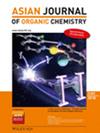On the Photoisomerization of Pyridine in Vapor Phase
IF 2.8
4区 化学
Q1 CHEMISTRY, ORGANIC
引用次数: 0
Abstract
DFT calculations on the photoisomerization of pyridine, 2,3‐, 2,6, and 3,4‐dimethylpyridine showed that the photoisomerization occurs through the formation of the corresponding Dewar isomers. These compounds can be transformed into the corresponding benzvalene isomers, whose decomposition gives the reaction products. Another way to obtain some observed reaction products is a photoisomerization of the Dewar isomers through an intramolecular thermal or photochemical [2+2]‐cycloaddition reaction.

求助全文
约1分钟内获得全文
求助全文
来源期刊

Asian Journal of Organic Chemistry
CHEMISTRY, ORGANIC-
CiteScore
4.70
自引率
3.70%
发文量
372
期刊介绍:
Organic chemistry is the fundamental science that stands at the heart of chemistry, biology, and materials science. Research in these areas is vigorous and truly international, with three major regions making almost equal contributions: America, Europe and Asia. Asia now has its own top international organic chemistry journal—the Asian Journal of Organic Chemistry (AsianJOC)
The AsianJOC is designed to be a top-ranked international research journal and publishes primary research as well as critical secondary information from authors across the world. The journal covers organic chemistry in its entirety. Authors and readers come from academia, the chemical industry, and government laboratories.
 求助内容:
求助内容: 应助结果提醒方式:
应助结果提醒方式:


